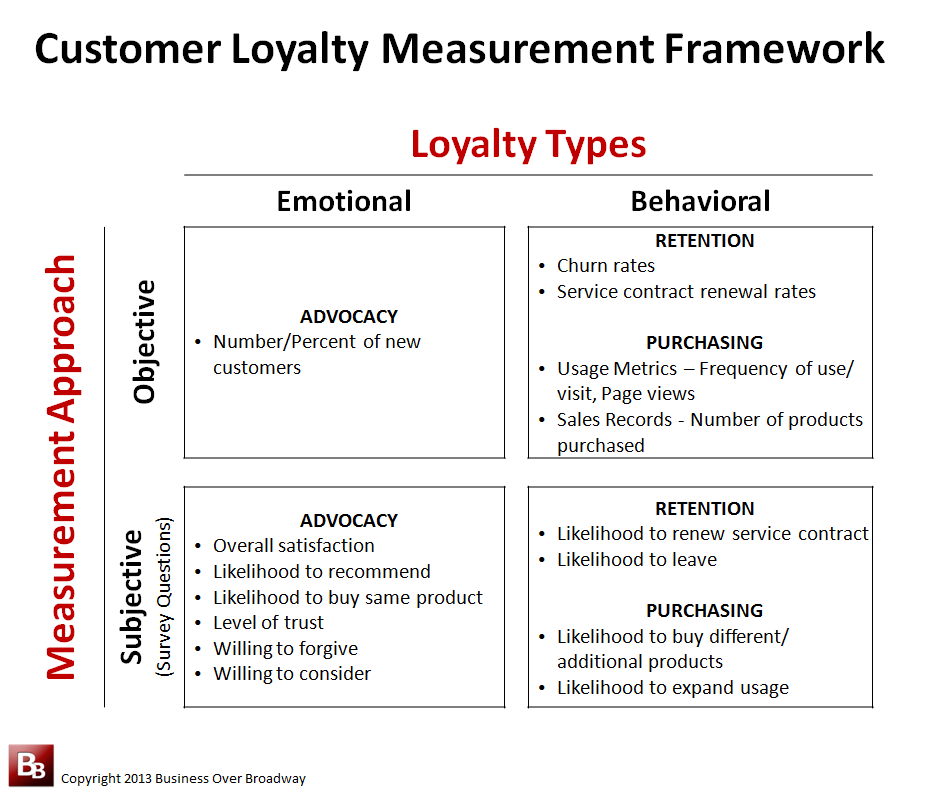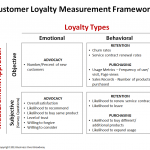Customer loyalty plays a key role in any customer experience management program. Customer loyalty reflects the degree to which customers engage in positive behaviors toward and experience positive feelings about a company or brand. Your customer loyalty metrics plays large part in your customer experience analytics efforts; the goal of analytics is to uncover ways to improve customer loyalty. Consequently, how you measure customer loyalty will necessarily impact the insights you get from your customer experience analytics. The difference between valuable and misleading insights rests on the loyalty metrics you use. In today’s post, I will talk about two important measurement factors you must consider when selecting your customer loyalty metrics.
Types of Customer Loyalty
First, you need to be cognizant of the multi-dimensional nature of customer loyalty. We know that customer loyalty is not a single thing. While I provided a pretty generic definition of customer loyalty above, when we consider how that definition translates into measuring the construct, we found that there are really three different types of customer loyalty:
- Retention loyalty – the extent to which customers will stay with you / not defect to a competitor
- Advocacy loyalty – the extent to which customers will recommend your company/brand
- Purchasing loyalty – the extent to which customers will expand their relationship with you by buying more and/or different products/services from you.
Each of these types of customer loyalty are responsible for different types of business growth. Retention loyalty leads to long-term customers who are easier to service. Advocacy loyalty brings in new customers. Purchasing loyalty increases the average revenue per customer. Our research also showed that different CX touch points impact the three types of customer loyalty differently. So, when considering your CX measurement plan, be sure you consider what type of loyalty you want to measure and manage.
Multiple Measurement Methods
After you define what type of loyalty you want to measure, the next step is to decide on how to measure it. There are two general approaches to measuring customer loyalty: 1) objective approach and 2) subjective (self-reported) approach.
- Objective measurement approach include system-captured metrics that involve hard numbers regarding customer behaviors that are beneficial to the company. Data can be obtained from historical records and other objective sources, including purchase records (captured in a CRM system) and other online behavior. Examples of objective loyalty data include computer generated records of “time spent on the Web site,” “number of products/services purchased” and “whether a customer renewed their service contract.”
- Subjective measurement approach involves “soft” numbers regarding customer loyalty. Subjective loyalty metrics include customers’ self-reports of their feelings about the company and behavior toward the company. Examples of subjective loyalty data include customers’ ratings on standardized survey questions like, “How likely are you to recommend <Company> to your friends/colleagues?”, “How likely are you to continue using <Company>?” and “Overall, how satisfied are you with <Company>?”
While I present two distinct customer loyalty measurement approaches, there are likely gradients of the subjective measurement approach. On one end of the subjective continuum, ratings are more perceptually based (what is typically used today) and, on the other end of the subjective continuum, ratings are more behaviorally based that more closely approximate the objective measurement approach. The objective/subjective dichotomy, however, provides a good framework for discussing measurement approaches.
Knowing that there are different types of customer loyalty and different ways to measure customer loyalty, you can now begin to operationalize our customer loyalty measurement strategy.
Customer Loyalty Measurement Framework
Whether you use an objective measurement approach or a subjective measurement approach, your customer loyalty metrics need to reflect one of the dimensions of customer loyalty: retention, advocacy and/or purchasing loyalty. Here are a few objective customer loyalty metrics businesses can use:
- Churn rates
- Service contract renewal rates
- Number/Percent of new customers
- Usage metrics – frequency of use/visits, page views
- Sales records – number of products purchased
Here are a few subjective customer loyalty metrics businesses can use:
- likelihood to renew service
- likelihood to leave
- overall satisfaction
- likelihood to recommend
- likelihood to buy different/additional products
- likelihood to expand usage

Figure 1. Customer Loyalty Measurement Framework: You can measure emotional (e.g., advocacy) and behavioral loyalty (e.g., retention and purchasing) using different measurement approaches (e.g., subjective and objective).
Figure 1 illustrates how these loyalty metrics fit into the larger customer loyalty measurement framework of loyalty types and measurement approaches. Each of the customer loyalty metrics above falls into one of the four quadrants of Figure 1.
I argue elsewhere that we need to use more objective metrics of customer loyalty whenever they are available. Using Big Data principles, companies can link real loyalty behaviors with customer satisfaction ratings. Using a customer-centric approach to linkage analysis, you can integrate customer feedback data with your CRM data where real customer loyalty data are housed (see CEM Linkage for a deeper discussion).
While companies have both objective and subjective measurement approaches at their disposal, surveys remain a popular approach to measuring customer loyalty. In fact, surveys remain the cornerstone of most customer experience management programs. Even though measuring customer loyalty using real, objective metrics (system-captured) would be ideal, many companies simply do not have the resources to collect and link customer loyalty behaviors to customer ratings of their experience.
Companies use customer surveys to measure customer loyalty rather than solely relying on objective metrics of customer loyalty because: 1) Customer surveys allow companies to quickly and easily gauge levels of customer loyalty, 2) Customer surveys can provide rich information about the customer experience that can be used to more easily change organizational business process and 3) Customer surveys provide a forward look into customer loyalty.
Summary
The measurement of customer loyalty is key to the success of your customer experience efforts. When determining your customer loyalty metrics for your CX program, you need to consider: 1) types of customer loyalty and 2) measurement methods of customer loyalty. Consider using the Customer Loyalty Measurement Framework to help you evaluate your current customer loyalty metrics. You may need to consider replacing your current loyalty measurement approach or, at least, augmenting your approach with a better, more comprehensive set of customer loyalty metrics.
An earlier version of this article originally appeared on Clicktools.




 Beyond the Ultimate Question
Beyond the Ultimate Question Measuring Customer Satisfaction and Loyalty (3rd Ed.)
Measuring Customer Satisfaction and Loyalty (3rd Ed.)
Comments are closed.